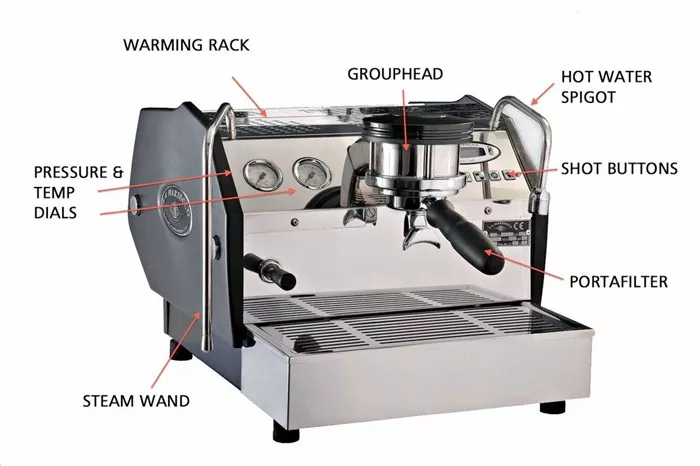Espresso machines are fascinating pieces of engineering that transform coffee grounds into a rich, concentrated shot of espresso. Whether you’re a barista, a coffee enthusiast, or just curious about how these machines work, this guide will break down every step in simple, logical terms.
We’ll cover:
- The Basic Components of an Espresso Machine
- How Water Heats Up and Moves Through the Machine
- The Brewing Process: From Grounds to Espresso
- Pressure’s Role in Espresso Extraction
- Different Types of Espresso Machines
- Maintenance and Cleaning
By the end, you’ll understand exactly how your espresso machine turns water and coffee into that perfect shot.
The Basic Components of an Espresso Machine
An espresso machine has several key parts that work together to brew coffee. Here’s what each one does:
Water Reservoir
- Holds fresh, cold water.
- Some machines connect directly to a water line (common in commercial setups).
Pump
- Creates pressure to push water through coffee grounds.
- Most home machines use an electric vibration pump, while commercial machines use a rotary pump.
Boiler or Heating Element
- Heats water to the right temperature (around 90–96°C or 194–205°F).
- Single boiler machines heat water for both brewing and steaming (but not at the same time).
- Dual boiler machines have separate boilers for brewing and steaming.
- Heat exchanger machines use one boiler but separate paths for brewing and steaming.
Portafilter
- A handle with a basket inside that holds the coffee grounds.
- The basket has tiny holes at the bottom where espresso flows out.
Grouphead
- The part where the portafilter locks in.
- Hot water from the boiler passes through here into the coffee.
Steam Wand
- Used to steam and froth milk for drinks like cappuccinos and lattes.
- Now that we know the parts, let’s see how they work together.
How Water Heats Up and Moves Through the Machine
Step 1: Water Intake
- Cold water is drawn from the reservoir or water line.
- The pump pushes it toward the boiler.
Step 2: Heating the Water
- The boiler heats the water to the ideal brewing temperature (90–96°C).
- If the machine has a heat exchanger, steam keeps the water hot without overheating it.
Step 3: Creating Pressure
- The pump builds up 9 bars of pressure (about 130 psi).
- This pressure forces hot water through tightly packed coffee grounds.
Step 4: Water Meets Coffee
- The pressurized hot water flows into the grouphead.
- It then passes through the coffee in the portafilter.
The Brewing Process: From Grounds to Espresso
Grinding and Tamping
- Coffee beans must be ground very fine (finer than table salt).
- The grounds are placed in the portafilter basket and tamped (pressed down firmly).
- Tamping ensures even water flow through the coffee.
Extraction
- When the machine starts, hot water is forced through the coffee at high pressure.
- The water dissolves flavors, oils, and caffeine from the grounds.
- A good extraction takes 25–30 seconds and produces 25–35ml of espresso.
The Crema
- The high pressure emulsifies coffee oils, creating a golden-brown foam called crema.
- Crema is a sign of a well-extracted espresso.
Pressure’s Role in Espresso Extraction
Pressure is what makes espresso different from regular coffee. Here’s why it matters:
Ideal Pressure: 9 Bars
- Too low (<7 bars): Weak, under-extracted coffee.
- Too high (>10 bars): Bitter, over-extracted coffee.
How Pressure Affects Flavor
- Forces water through tightly packed coffee quickly.
- Extracts rich flavors and aromas that drip coffee can’t.
Types of Pumps
- Vibration Pump (common in home machines): Loud but effective.
- Rotary Pump (commercial machines): Quieter, more durable.
Different Types of Espresso Machines
Not all espresso machines work the same way. Here are the main types:
Manual Lever Machines
- The oldest type; the user controls pressure with a lever.
- Requires skill but allows for precise extraction.
Semi-Automatic Machines
- Most common in homes and cafes.
- The user starts and stops the shot manually.
Automatic & Super-Automatic Machines
- Automatic: Stops the shot after a set volume.
- Super-automatic: Grinds, tamps, and brews with one button.
Pod Machines
- Use pre-packaged coffee pods.
- Convenient but less control over flavor.
Maintenance and Cleaning
An espresso machine needs regular care to work well.
Daily Cleaning
- Wipe the steam wand after each use.
- Rinse the portafilter and grouphead.
Weekly Deep Cleaning
- Backflush the machine with a cleaning tablet.
- Descale to remove mineral buildup.
Replacing Parts
- Grouphead gaskets wear out and should be replaced yearly.
- Shower screens can get clogged and need cleaning.
Conclusion
Espresso machines are complex but follow a simple principle: force hot water through finely ground coffee at high pressure. Understanding how they work helps you brew better espresso and maintain your machine properly.
Whether you prefer a manual lever or a super-automatic machine, the magic of espresso lies in the balance of temperature, pressure, and time. Now that you know how it all works, you can appreciate every shot even more! Would you like recommendations for the best home espresso machines? Let me know!
Related topics:
How to Make Cappuccino with Nespresso Vertuo?
How to Descale a Nespresso Vertuo


